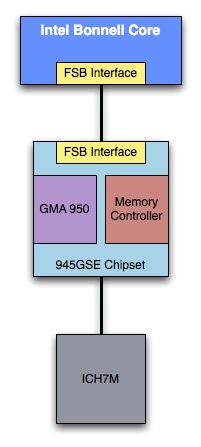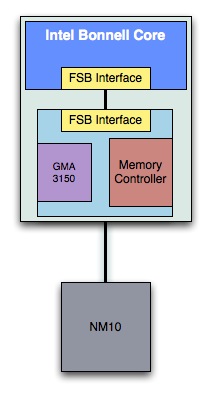Intel Unveils Moorestown and the Atom Z600, The Fastest Smartphone Platform?
by Anand Lal Shimpi on May 4, 2010 11:54 PM EST- Posted in
- Smartphones
- Intel
- Atom
- Mobile
- SoCs
The World Changes, MIDs Ahead of Their Time
Silverthorne lacked integration, which wasn’t a problem for MIDs and netbooks, but it kept the chip out of smartphones. Between 2004 and Atom’s introduction in 2008 the iPhone happened. All of the sudden the clunky MIDs we were reluctantly waiting for stopped being interesting. What we wanted were more iPhones, and iPhone clones. Then came Android and the rest is history. While Atom had tremendous success in netbooks, Intel’s decision to pursue a discrete route first kept it out of smartphones.
Luckily, next on the list after the first Atom was a more integrated one with the goal of dropping power consumption. We saw this with Pine Trail, the netbook Atom that brought the memory controller and GPU on-die. Performance didn’t improve because unlike most integrated memory controllers, this one still connected to the CPU via a FSB.
Intel Atom "Diamondville" Platform 2008 |
Intel Atom "Pine Trail" Platform 2009-2010 |
 |
 |
Pine Trail still has all of the bells and whistles of a PC platform however. Take the PCI bus for example. Every 12 microseconds it wakes up and polls every IO on the platform. That kills idle battery life, especially when you’ve got a tiny smartphone battery. Pine Trail is useless for smartphones, and that’s where Moorestown comes in.
If you thought this was the netbook Atom squeezed into a smartphone, you’re very wrong. It’s got a completely different memory controller, a true smartphone GPU (the same core, but clocked higher than what’s in the iPhone 3GS) and a ton of power optimizations that just don’t exist in the netbook version. The chipset is also very different. The PCI bus is gone as is anything that could ruin power consumption. Intel did a lot of optimization and a lot of cutting here. What resulted is something that looks a lot like a smartphone hardware platform and nothing like what we’re used to seeing from Intel.
This is Moorestown.










67 Comments
View All Comments
Mike1111 - Wednesday, May 5, 2010 - link
IMHO Anand meant app-centric smartphones, David Pogue calls them app phones.jasperjones - Wednesday, May 5, 2010 - link
i don't see how recent symbian devices are not "app centric." you have the publicly available sdk, the ovi store, etc.BrooksT - Wednesday, May 5, 2010 - link
So your argument is that symbian is a bigger player in the app phone market than Apple because their *latest* phones support apps?The "smartphone" / "app phone" semantic difference is annoying, but if we look at, say, number of applications available or downloaded, Symbian and RIM are distant third and fourth places. Likewise with app usage, even just internet browsing.
If you want to talk about smartphones as they existed in 2006, then yes, both Symbian and RIM are much bigger than Apple or Android.
jasperjones - Wednesday, May 5, 2010 - link
To clarify: I said "recent" because the first Symbian smartphones came out almost 10 years ago--of course, those weren't app-centric.My original comment on Anand's article still stands. I'm talking about IDC's and Canalys' reports on 2010:Q1 smartphone sales which became available just days ago. Of course, most of the smartphones sold by Nokia and RIM in the first quarter allow for installation of apps such as Facebook, Ovi Maps, etc., etc.
WaltFrench - Sunday, May 9, 2010 - link
“…Apple and Google dominate the smartphone market. This is utter nonsense.”All you have to do is to look at the developer space. How many app developers are creating apps for the unreleased RIM OS 6? … for the Symbian OS^3, due out in “select” markets sometime in Q3?
If older apps work OK in these new OS incarnations, and if Blackberry and Nokia users are heavy app downloaders (or for some reason will become heavy users), then the current sales-share leaders are relevant, but still not dominant, in the future of app phones.
nafhan - Wednesday, May 5, 2010 - link
I'm curious about the PCI bus requirement for Windows 7 that would prevent it from running on Moorestown devices. Does it have something to do with storage, maybe? I'm having trouble finding specifics online as well. If someone could enlighten me, it would be appreciated.DanNeely - Wednesday, May 5, 2010 - link
This is almost certainly a factor of windows being a monolithic kernel and MS not having any way to say "this PC doesn't do PCI". This is something that MS will have to deal with in the medium term future anyway. PCI slots are going away from some high end mobos; it's only a matter of time before they disappear from mainstream boards and stop being used to attach misc controllers like PATA (slowly going away entirely) or FireWire (FW3200 will need PCIe bandwidth). At that point intel will want to take it out of their chipsets as a cost saving feature, and oems will not be happy if they have to install a PCIe to PCI bridge to maintain windows compatibility.Drizzt321 - Wednesday, May 5, 2010 - link
Maybe HP/Palm should get with Intel and optimize WebOS for this. Much of the WebOS stack is just Linux, Webkit, plus other F/OSS stuff like gstreamer and the like so I wouldn't be surprised if it isn't as big an effort as, say, Symbian or anything like that.This could be a big break for Intel and HP/Palm, since HP/Palm needs something big to help it move on to the next WebOS device, and the OS could certainly see some benefits to more CPU power. I've heard the overclocking patches raising the CPU to 800MHz can really help things.
sleepeeg3 - Wednesday, May 5, 2010 - link
Please stop designing faster phones.Phone A lasts 24 hours standby
Phone B lasts 6 hours standby
After 6 hours, Phone B's battery is dead. How much use do you get out of a phone with a dead battery? 0.
999GHz x 0 is still... 0!
This push toward faster phones, without even considering battery life, is nuts. Phones are impractical tools for just about everything, but calling, messaging and photographs. None of these are CPU intensive. Dependability is more important than how fast the dial screen opens.
Moorestown may include better power architecture, but it throws this away by jacking up the processor speed.
Lets get back to practicality and make phones functional again. This push toward cutesy 1000mAH/1GHz+ phones that die in a few hours is moronic.
Is it too much to ask for phones that last a week?
metafor - Thursday, May 6, 2010 - link
There are plenty of phones that last a week...They even cost significantly less than GHz smartphones and usually don't come with a 2-year contract.
But they don't have giant 4.2" AMOLED screens (which btw, is ~50% of the power consumption) either.